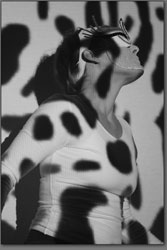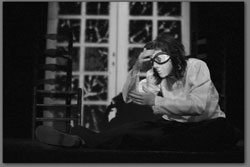| ||||||
Theater of the imagination
by Jules Masterjohn Theater of the imagination returns to the Abbey Theater with a new multimedia performance, “Oblivion,” brought to us by the same three creative minds that presented “Penumbra” earlier this year. Utilizing traditional theater, technology and collaboration to highlight their individual visions, producer Stacey Sotosky, director LeAnn Brubaker and writer Alex Oliszewski have created their most ambitious project to date. Amidst the complexities of this production, there is a plot line that ties together the various technologies and media. It goes like this: Once upon a time in an era known only in the imagination, a thick fog rolls over a small town where a young blind girl, Inomy, her baby brother, and parents reside. The fog, as Oliszewski states, “creates a world in which everyone is made blind. Where the rainbow can no longer find its way down from the sky, and the unknown depths of the world are safe to come out and work their will.” These underworld forces make their appearance in the form of a bat named Bouba and the bereaved queen of the underworld, the Lady of the Dead Forest. Grief stricken and insane from the loss of her own child, the Lady of the Dead Forest sends her loyal servant, Bouba, to kidnap Inomy’s infant brother, which the Lady understands to be her own dead child. Oliszewski continues, “Inomy is given an opportunity to show how her seeming handicap is in fact her strongest resource. Having never been able to see, she has learned how to travel about her home without her eyes. When the fog rolls in and blinds the world, Inomy is not afraid, for she has never been able to see. In fact, her family realizes that she is in the best position to do what must be done to rescue them from the gaping mouth of Oblivion.” Inomy, shielded by her innocence and inability to see the terrifying aspects of the material world, travels unafraid, into the underworld to retrieve her brother. This journey, with mythic overtones similar to Orpheus or the Demeter and Persephone tales, offers the story its moral: There are dark and shadowy things that must be confronted, and sacrifice may be involved, in order to bring about the full and balanced potential of humanity. Here the story’s action is set in motion and moves forward through the use of video projection, computerized sound and lighting. Writer Oliszewski engineered the sound from an original score by Michael Coble. Sotosky and Brubaker created the video sequences. Brubaker also worked the lighting magic, along with six other prop and costume makers who added their talents to the production. During a month of intensive production, all these elements were interwoven with eight actors to create a performance rich with color, texture, movement and sound. The end result transports the audience into a world of illusion and archetypal symbolism. The genesis of this multimedia production is rooted in the creative team’s exposure to new media while studying together at Fort Lewis College. Influenced by the work of video artist Bill Viola, the innovative dance of Merce Cunningham, the sound/music experimentation of John Cage, and the history of performance art, the three created this energetic and, for Durango, cutting-edge production.
The genesis of this multimedia production is rooted in the creative team’s exposure to new media while studying together at Fort Lewis College. Influenced by the work of video artist Bill Viola, the innovative dance of Merce Cunningham, the sound/music experimentation of John Cage, and the history of performance art, the three created this energetic and, for Durango, cutting-edge production. “Through these examples we learned the possibilities of collaboration and the spectrums of the creation process,” Sotosky explained. “Now we use some traditional theater roles but continue to sculpt a system for creating that meets our individual interests. We each remain open and flexible to create local theatre with universal possibilities that furthers our individual goals as artists.” The production hinges on a story that emerged from a “round table storytelling process” where the objective was to “tell a stark and spooky story,” according to Oliszewski. “We all contributed bits and pieces of our nightmares to take the story on a dark journey,” he said. “As it was my job to write the final script, I ended up putting a lot of things in about the world that scares me … blindness, loss of family, insanity and the loss of memory.” The actors’ characterizations are achieved through a mime style, as their spoken lines are all prerecorded on a soundtrack that mixes dialogue and sound effects. A challenging acting style for both actor and audience, I was most mesmerized by Talia Bammerick’s convincing and empathetic embodiment of Bouba, the bat. With so many creative contributors, a piece with such technical intricacy can run the risk of seeming disjointed and fragmented. Aesthetic continuity is achieved through the use of projected video images, both moving and stationary, onto screens positioned in various yet consistent places on the stage throughout the production. The screens are used like “flats” in traditional theater, which define the different scenes or locations in the performance. These projection screens are not only the backdrops for the scene-defining images, showing a window or a door. They also indicate the passage of time or the transportation to another realm. For example, a swirling spiral is used numerous times throughout the piece. When asked what experience she wants audience members to leave with after viewing “Oblivion,” Brubaker responded, “‘I want the audience to be blown away by the technical spectacle and chilled to the bone by the story line. I want people to be amazed that this kind of theater was grown right here in Durango, and to appreciate the artistic, creative people from all over the community that make it happen.” •
|
In this week's issue...
- May 15, 2025
- End of the trail
Despite tariff pause, Colorado bike company can’t hang on through supply chain chaos
- May 8, 2025
- Shared pain
Dismal trend highlights need to cut usage in Upper Basin, too
- April 24, 2025
- A tale of two bills
Nuclear gets all the hype, but optimizing infrastructure will have bigger impact




